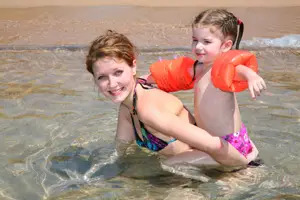Consult our tips before you head to the shore this summer, and be confident that your children are prepared for swimming in the ocean.
 For most families, summer wouldn’t be complete without at least one trip to the beach. The tri-state area has hundreds of miles of shoreline, with many areas reserved for public access. While many children are content to play on the beach, most young kids are eager to test the water, which can be rough, unpredictable, and dangerous.
For most families, summer wouldn’t be complete without at least one trip to the beach. The tri-state area has hundreds of miles of shoreline, with many areas reserved for public access. While many children are content to play on the beach, most young kids are eager to test the water, which can be rough, unpredictable, and dangerous.
Swimming in any body of water comes with its share of risks, but the ocean provides a heightened set of circumstances that parents should be fully aware of. To be sure, a child’s first swimming experience should be in the controlled environment of a pool. In the relative safety of a pool, children have the ability to hold on to the side for balance, see and feel the bottom surface, and move about at their own pace.
Joe Scalise, the Director of Lifeguards for Long Island State Parks, presides over some of the area’s most beautiful – and precarious – stretches of shoreline in the area. Scalise is quick to point out some of the key distinctions between pool and ocean swimming. “There’s really a big difference. In the ocean there’s the presence of waves and a certain roughness of water, and visibility is very much a question, as there is often no clarity to the water. There’s just a lot of unpredictability in the ocean. Kids can step on crabs and shells. The water temperature can change rapidly.” And that’s just the beginning. There’s also the danger of riptides, a common occurrence on the south shore of Long Island, along the Jersey shore, and at many ocean beaches throughout Connecticut.
While the laundry list of dangers involved in ocean swimming can scare off some parents, Scalise suggests some key precautions that parents can take to ensure a safer day at the beach. To begin with, children and their parents should already be seasoned swimmers before entering ocean waters. “If they’re not strong swimmers, they don’t belong in the ocean,” Scalise says. He suggests that children swimming in the ocean should always have a buddy, and that they should swim directly in front of a lifeguard.
| The United States Lifesaving Association’s Top 10 Safety Tips |
Even in the presence of lifeguards, Scalise says, parents play an essential role in ocean safety. “Good judgement is paramount,” he says. “Parental instinct and care of your own child is monumental. Lifeguards are scanning – and they are only one set of eyes. Parents should watch kids, too.” In addition, parents are often closer to their child than the lifeguards who are perched up in a chair. Scalise also points to the importance of the supervising parents being good swimmers, as he has seen parents who attempt to help their children get into trouble themselves.
While floating devices like swimmies are encouraged in the pool, they are not permitted at most area beaches. “Nothing is allowed in the ocean,” Scalise says. “Devices often give a false sense of security. They can work against you if the waves are pounding in. And if the wind is blowing offshore they can sweep a young body out to sea.” Parents are better off holding their child by the hand in the ocean, and staying in shallow water, than using a device as a crutch for poor swimming.
While parents play a crucial role in protecting their children from the hazards of ocean swimming, ambivalent or overconfident parents may have a negative impact on their child’s progression from pool to ocean. “Kids will know when they’re ready. Sometimes parents don’t,” Scalise says. “I’ve seen parents holding kids and dunking them in the water too early. They need to allow for a natural progression. It really depends on what the parents have exposed their children to. Some 3-year-olds are comfortable in the ocean. But you’ve always got to be careful.”
Scalise is quick to point out that many of his suggestions for safe ocean swimming also apply to swimming in a pool or lake. He reiterates that families should know their limits and act accordingly; parents should always watch their kids; and children should swim in front of lifeguards. Parents should never allow their children to swim alone, and should protect against neck injury by making sure their kids don’t dive headfirst into any body of water.
Like every other area of parenting, knowing when to take the dive into ocean waters involves good judgment. Check out the U.S. Lifesaving Association’s Top 10 Safety Tips, start slowly in tame pool waters, and head to the shore with confidence!





















